Related Research Articles

Excalibur is the legendary sword of King Arthur, sometimes also attributed with magical powers or associated with the rightful sovereignty of Britain. It was associated with the Arthurian legend very early on. Excalibur and the Sword in the Stone are not the same weapon, though in some modern incarnations they are either the same or at least share their name. In Welsh, it is called Caledfwlch; in Cornish, Calesvol ; in Breton, Kaledvoulc'h; and in Latin, Caliburnus. Several similar swords and other weapons also appear in this and other legends.

The Holy Grail is a treasure that serves as an important motif in Arthurian literature. Various traditions describe the Holy Grail as a cup, dish, or stone with miraculous healing powers, sometimes providing eternal youth or sustenance in infinite abundance, often guarded in the custody of the Fisher King and located in the hidden Grail castle. By analogy, any elusive object or goal of great significance may be perceived as a "holy grail" by those seeking such.

Lancelot du Lac, also written as Launcelot and other variants, is a character in some versions of Arthurian legend, where he is typically depicted as King Arthur's close companion and one of the greatest Knights of the Round Table. In the French-inspired Arthurian chivalric romance tradition, Lancelot is an orphaned son of King Ban of the lost Kingdom of Benoic, raised in the fairy realm by the Lady of the Lake. A hero of many battles, quests and tournaments, and famed as a nearly unrivalled swordsman and jouster, Lancelot becomes the lord of the castle Joyous Gard and personal champion of Arthur's wife, Queen Guinevere, despite suffering from frequent and sometimes prolonged fits of madness. But when his adulterous affair with Guinevere is discovered, it causes a civil war that, once exploited by Mordred, brings an end to Arthur's kingdom.
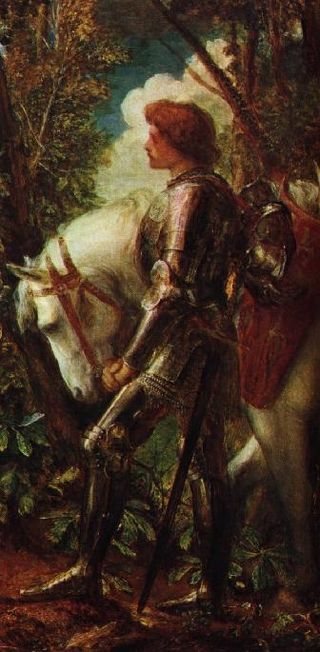
Galahad, sometimes referred to as Galeas or Galath, among other versions of his name, is a knight of King Arthur's Round Table and one of the three achievers of the Holy Grail in Arthurian legend. He is the illegitimate son of Sir Lancelot du Lac and Lady Elaine of Corbenic and is renowned for his gallantry and purity as the most perfect of all knights. Emerging quite late in the medieval Arthurian tradition, Sir Galahad first appears in the Lancelot–Grail cycle, and his story is taken up in later works, such as the Post-Vulgate Cycle, and Sir Thomas Malory's Le Morte d'Arthur.

The Knights of the Round Table are the knights of the fellowship of King Arthur in the literary cycle of the Matter of Britain. First appearing in literature in the mid-12th century, the Knights are an order dedicated to ensuring the peace of Arthur's kingdom following an early warring period, entrusted in later years to undergo a mystical quest for the Holy Grail. The Round Table at which they meet is a symbol of the equality of its members, who range from sovereign royals to minor nobles.
Percival's sister is a role of two similar but distinct characters in the Holy Grail stories within the Arthurian legend featuring the Grail hero Percival (Perceval). The first of them is named Dindrane, the second is usually unnamed and is known today as the Grail heroine.

The Fisher King is a figure in Arthurian legend, the last in a long line of British kings tasked with guarding the Holy Grail. The Fisher King is both the protector and physical embodiment of his lands, but a wound renders him incapable and his kingdom barren. Unable to walk or ride a horse, he is sometimes depicted as spending his time fishing while he awaits a "chosen one" who can heal him. Versions of the story vary widely, but the Fisher King is typically depicted as being wounded in the groin, legs or thigh, rendering him infertile. The healing of these wounds always depends upon the completion of a hero-knight's task.

Bors is the name of two knights in Arthurian legend, an elder and a younger. The two first appear in the 13th-century Lancelot-Grail romance prose cycle. Bors the Elder is the King of Gaunnes (Gannes/Gaunes/Ganis) during the early period of King Arthur's reign, and is the brother of King Ban of Benoic and the father of Bors the Younger and Lionel. His son Bors the Younger later becomes one of the best Knights of the Round Table and participates in the achievement of the Holy Grail.

In Arthurian legend, the Siege Perilous is a vacant seat at the Round Table reserved by Merlin for the knight who would one day be successful in the quest for the Holy Grail.

Gaheris is a knight of the Round Table in the chivalric romance tradition of Arthurian legend. A nephew of King Arthur, Gaheris is the third son of Arthur's sister or half-sister Morgause and her husband Lot, King of Orkney and Lothian. He is the younger brother of Gawain and Agravain, the older brother of Gareth, and half-brother of Mordred. Le Morte d'Arthur depicts Gaheris as little more than a supporting character to Gawain, with an odd exception of his murder of their mother. His role is greater in the French prose cycles, including as an object of murderous sibling rivalry by Agravain in the Vulgate Cycle. Inevitably, however, he is killed alongside Gareth during Lancelot's rescue of Guinevere, the event that will lead to the fall of Arthur.

The Lancelot-Grail, also known as the Vulgate Cycle or the Pseudo-Map Cycle, is an early 13th-century French Arthurian literary cycle consisting of interconnected prose episodes of chivalric romance in Old French. The cycle of unknown authorship, presenting itself as a chronicle of actual events, retells the legend of King Arthur by focusing on the love affair between Lancelot and Guinevere as well as the religious quest for the Holy Grail, expanding on the works of Robert de Boron and Chrétien de Troyes.

The Post-Vulgate Cycle, also known as the Post-Vulgate Arthuriad, the Post-Vulgate Roman du Graal or the Pseudo-Robert de Boron Cycle, is one of the major Old French prose cycles of Arthurian literature from the early 13th century. It is considered essentially a rewriting of the earlier Vulgate Cycle, with much left out but also much added, including characters and scenes from the Prose Tristan.
Sarras is a mystical island to which the Holy Grail is brought in the Arthurian legend. In the Lancelot-Grail Cycle, Joseph of Arimathea and his followers visit the island on their way to Britain; while there Joseph's son Josephus is invested as a bishop and shown the mysteries of the Grail by Christ himself. The party wins many converts, and moves on to Britain where they establish a great line of kings. After they achieve the Grail the knights Galahad, Percival, and Bors return the object to Sarras aboard Solomon's ship, but they find the residents fallen back to paganism. The Grail knights restore the people's faith and preside over them benevolently for a year, but Galahad dies in ecstasy when the Grail is taken to Heaven by God, and Percival follows him shortly after. Bors returns to Arthur's kingdom to tell the tale.
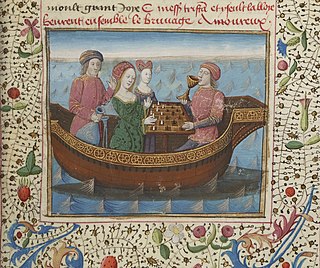
The Prose Tristan is an adaptation of the Tristan and Iseult story into a long prose romance, and the first to tie the subject entirely into the arc of the Arthurian legend. It was also the first major Arthurian prose cycle commenced after the widely popular Lancelot-Grail, which influenced especially the later portions of the Prose Tristan.
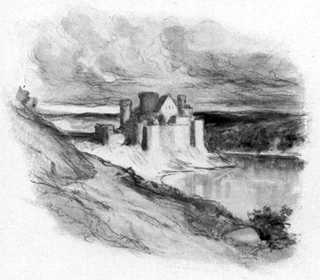
Corbenic is the name of the Grail castle, the edifice housing the Holy Grail in Arthurian legend. It is a magical domain of the Grail keeper, often known as the Fisher King. The castle's descriptions vary greatly in different sources, and it first appears by that name in the Lancelot-Grail cycle where it is also the birthplace of Galahad.
Perlesvaus, also called Li Hauz Livres du Graal, is an Old French Arthurian romance dating to the first decade of the 13th century. It purports to be a continuation of Chrétien de Troyes' unfinished Perceval, the Story of the Grail, but it has been called the least canonical Arthurian tale because of its striking differences from other versions.
Agrestes was, according to the 13th-century Arthurian Vulgate Cycle, a pagan king of Camelot in the time of Joseph of Arimathea. Though the Lancelot section of the cycle has him converted by Joseph himself, the Estoire del Saint Graal section, written after the Vulgate Lancelot as a prequel, states that Joseph's son Josephus converted him. He persecuted those of his people who converted to Christianity under Josephus' influence:
When Josephus, the son of Joseph of Arimathea, began converting Agrestes’ people to Christianity, the king pretended to go along. As soon as Josephus had left, however, Agrestes forced his people back to their heathen religion and killed the disciples that Josephus had left in the city. Following this massacre, Agrestes went mad, began to eat his hands, slaughtered his family, and finally committed suicide by diving into a fire. After his death, Josephus returned and converted Camelot to Christianity for good.
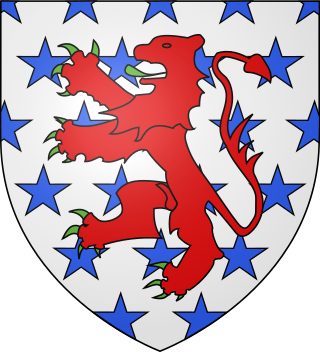
Galehaut is a half-giant knight and sovereign prince in the Arthurian legend. He is most prominent within the Lancelot-Grail prose cycle where he is a noble enemy turned an ally of King Arthur as well as an inseparable friend of Arthur's champion Lancelot. The figure of Galehaut should not be mistaken with Lancelot's son, Galahad, and some other similarly named characters.
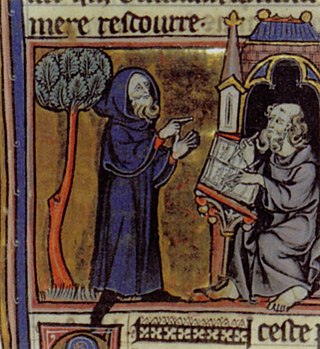
Merlin is a partly lost French epic poem written by Robert de Boron in Old French and dating from either the end of the 12th or beginning of the 13th century. The author reworked Geoffrey of Monmouth's material on the legendary Merlin, emphasising Merlin's power to prophesy and linking him to the Holy Grail. The poem tells of his origin and early life as a redeemed Antichrist, his role in the birth of Arthur, and how Arthur became King of Britain. Merlin's story relates to Robert's two other reputed Grail poems, Joseph and Perceval. Its motifs became popular in medieval and later Arthuriana, notably the introduction of the sword in the stone, the redefinition of the Grail, and turning the previously peripheral Merlin into a key character in the legend of King Arthur.
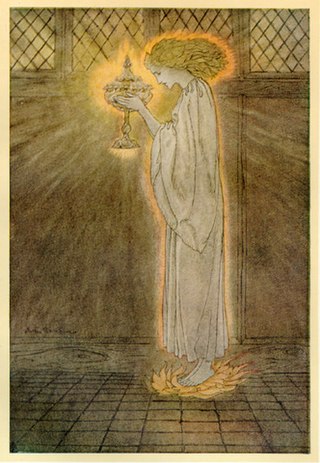
Elaine or Elizabeth, also known as Amite, and identified as the "Grail Maiden" or the "Grail Bearer", is a character from Arthurian legend. In the Arthurian chivalric romance tradition, she is the daughter of the Fisher King, King Pelles of Corbenic, and the mother of Galahad from her rape of Lancelot. She should not be confused with Elaine of Astolat, a different woman who too fell in love with Lancelot.
References
- ↑ Lacy, Norris J. (editor). Lancelot-Grail: The Old French Arthurian Vulgate and Post-Vulgate Cycles in Translation, volumes I and IV.
- ↑ Vern G. Swanson (2006). Dynasty of the Holy Grail: Mormonism's Sacred Bloodline. Cedar Fort, Utah, USA: Cedar Fort Inc. p. 189. ISBN 9781555178239 . Retrieved 5 August 2012.